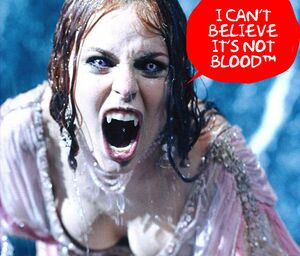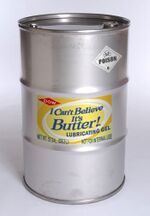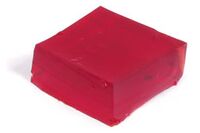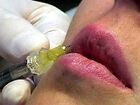Blood substitute
Blood substitutes, also known as artificial blood, blood surrogates, fake blood or Kool-Aid, are a category of substances used to imitate the properties of real blood. Their main purpose is to provide the majority of the modern vegan vampire diet. Originally a fringe health food, they now come in many different categories and even more flavors. They are occasionally pumped back into hypovolemic humans as an I.O.U.
History[edit]
Historical background[edit]
Vampires have traditionally hunted down live humans to drink their blood from. This ensured proper nutrition and provided an additional means of reproduction, creating more vampires. The vampire community prospered during this time.
Beginning in the early 1900s, humanity started becoming more conscious of their impact on the environment, and began to openly discuss their societal responsibilities for a sustainable future. Vampires also began questioning their impact on the planet, particularly on humans as their primary food source. More educated individuals wondered if their rate of growth could be sustained if they continued to feast only on people; sooner or later, they could overwhelm the ecosystem and be forced to prey upon one another, violating cultural norms. In fact, this situation had happened previously during the Black Plague, which nobody wanted a repeat of.
Vampires also benefited from mankind's advances in medical education, and learned of all the harmful diseases they were exposing themselves to in real blood. Some of these diseases could be traced back to the meatpacking industry through Upton Sinclair's recent book The Jungle, which revealed how people who ate meat contaminated with rat feces could transmit dissolved rat feces through their blood in turn to vampires. Affected vampires could then transmit these bloodborne illnesses, including HIV/AIDS, to subsequent victims. Protection proved impractical, however: a vampire attempting to bite someone while wearing a condom over each fang quickly killed the mood for both parties involved.
A dietary crisis resulted. Vampires stopped buying condoms for their fangs, causing the value of stocks for those manufacturing companies to plummet. Investors panicked and tried selling everything they could, triggering The Great Depression.
First invention[edit]
President Franklin D. Roosevelt had two main goals for his New Deal program: to revive the economy by finding a lucrative alternative to fang condoms, and prevent the upcoming starving vampire apocalypse. Government funding was quickly authorized for research centered on these tasks.
Henry Ford was tapped to find a solution to these urgent issues. His assembly line technique could be used to manufacture products quickly, but nobody wanted even more fang condoms. Some inspiration was needed. Ford was reading the newspaper one day when he saw an article on how President Roosevelt was introducing new regulations on food additives. He suddenly thought, "Why not just give vampires fake blood made entirely of food additives?"
Ford enlisted the help of Colonel Sanders, an aspiring chef without an established track record, to come up with the prototype for his new blood substitute idea. Sanders came up with a secret mix of herbs and spices, which he found personally appealing. This did not do well with volunteer vampires, however, who found the mixture "tasted like chicken." Sanders held onto the original recipe for his own plans later on, but went back to the drawing board and created a new secret mixture which did much better with the taste testers. Ford and Sanders applied for a joint patent on the mixture, and sold it commercially as I Can't Believe It's Not Blood!™. The new food substitute was an overnight sensation, and an industry was born.
Major brands[edit]
I Can't Believe It's Not Blood!™[edit]
The original brand of blood substitute that Henry Ford and Colonel Sanders invented and marketed. Owing to laws regarding patents, they had a legal monopoly on the blood substitute market for 20 years, after which point the patent expired. Their clientele essentially dried up after this, partly due to the initially catchy but ultimately unwieldy name, and partly because better mixtures came along. Some vampires also claimed the product had a chickeny aftertaste, but this was traced back to a manufacturing incident involving hydrogenated oils, and full refunds were offered.
I Can't Believe It's Not Blood!™ is the oldest surviving brand still on the market, although it is now primarily aimed at medical applications.
Jell-O[edit]
Jell-O is the immediate precursor to Kool-Aid, but only the cherry red variety. It is in a highly viscous state, which makes it suitable as baby food for infant vampires. Hospitals may also perform Jell-O transfusions on patients when they lose so much blood they flatten out, so they look plump and jiggly again. It also makes the heart work harder to pump blood throughout the body, which qualifies as great cardiovascular exercise; in this case, it can be considered a type of elective surgery.
Tomato juice[edit]
Tomato juice is nowadays considered a stereotypical drink for the health-conscious vampire, although in reality many eschew it because it tastes gross. Not even many humans will touch it. It's also unsuitable for medical uses, where injecting it into the bloodstream causes explosive diarrhea. Manufacturing of it has almost completely stopped, if not for Taco Bell reusing it in trace amounts as part of its ground beef recipe.
Kool-Aid[edit]
Kool-Aid is the most popular blood substitute amongst human and vampire children alike. Parents from both groups have accused the manufacturers of adding illegal chemicals for the coloring, but these claims have been largely dismissed. They seemed to start after the Jonestown massacre, where hundreds of young vampires were poisoned by racists.
Other uses[edit]
Medical[edit]
Blood substitutes deemed less tasty by vampires are often reserved for hospital use, although any such substance can be a viable replacement for blood in the circulatory system. They are used for E.R., phlebotomy and surgery patients suffering from severe blood loss. A registered nurse will connect an IV containing a red-colored liquid to a vein in the patient, replenishing the "red stuff they spilled all over the floor". A janitor is then tasked with mopping up the blood into a bucket together with dirty water, which is then pumped into the patient later once they're feeling better.
I.O.U.[edit]
Sympathetic vampires who still drink human blood, despite knowing the risks, will often pump blood substitutes back into their victims after feeding, hoping they won't notice the difference. This practice is commonly referred to as giving the victim an I.O.U. This typically results in increased mosquito bites for the victim however, since it's been scientifically established that 9 out of 10 mosquitos prefer cherry-flavored sugar water.



